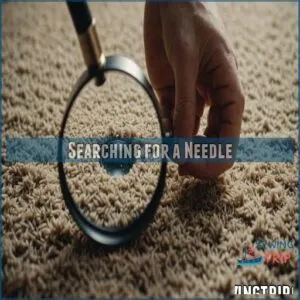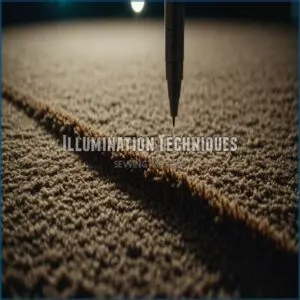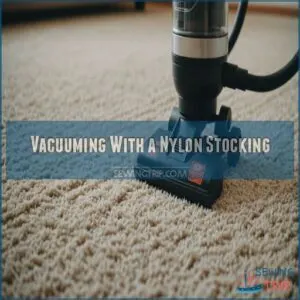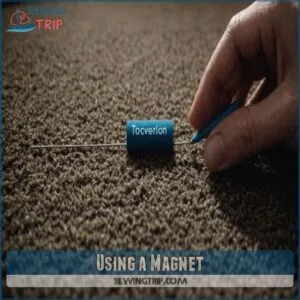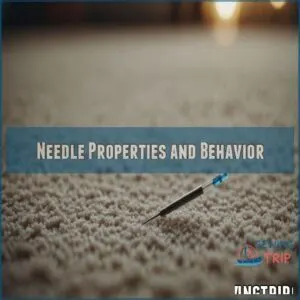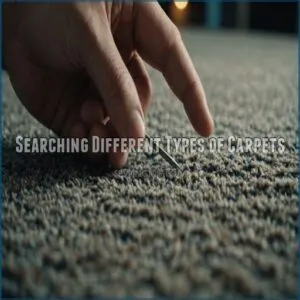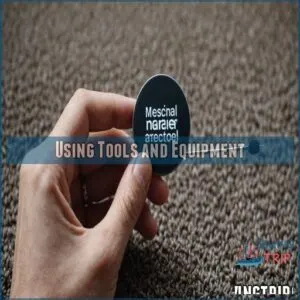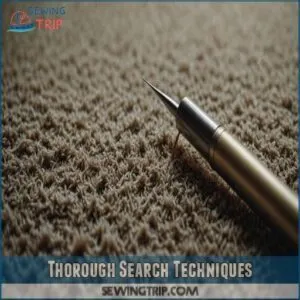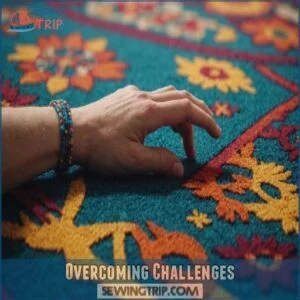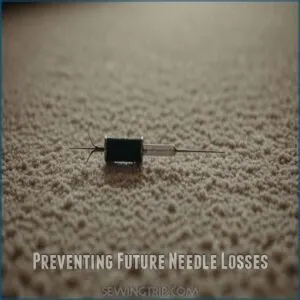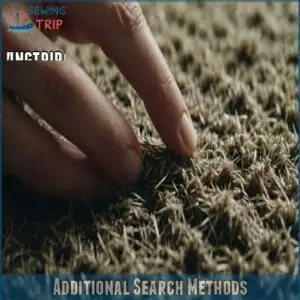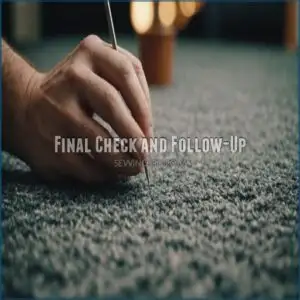This site is supported by our readers. We may earn a commission, at no cost to you, if you purchase through links.
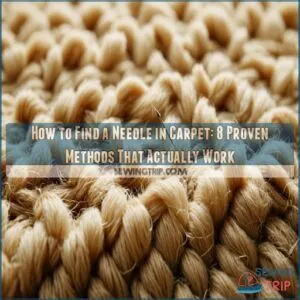 Looking for a needle in carpet might feel like a search for a lost treasure in a sea of fibers, but don’t fret!
Looking for a needle in carpet might feel like a search for a lost treasure in a sea of fibers, but don’t fret!
Start by running a vacuum with a nylon stocking over the hose, as the needle will cling like magic.
Shining a flashlight at a low angle can reveal its metallic glint amidst the carpet.
If you’re into gadgets, a sweeping magnet or metal detector might become your new best friends.
These tricks make finding how to find a needle in carpet a challenging yet achievable quest.
Next, let’s explore even more savvy strategies hidden up our sleeve!
Table Of Contents
- Key Takeaways
- Searching for a Needle
- Methods to Find a Needle
- Needle Properties and Behavior
- Searching Different Types of Carpets
- Using Tools and Equipment
- Thorough Search Techniques
- Overcoming Challenges
- Preventing Future Needle Losses
- Additional Search Methods
- Final Check and Follow-Up
- Frequently Asked Questions (FAQs)
- Conclusion
Key Takeaways
- You’ll need good lighting and a systematic search pattern to spot the needle’s glint or shadow.
- A strong magnet or vacuum cleaner with a nylon stocking can effectively retrieve magnetic needles.
- Prioritize safety by wearing protective footwear and clearing the area before searching.
- Prevent future losses by using a pincushion and organizing your needles properly.
Searching for a Needle
You’ll need a clear plan and steady nerves when that pesky needle vanishes into your carpet’s fibers.
Before you start your search, put on protective slippers and grab a flashlight – trust me, you don’t want to find that needle with your bare feet.
Preparation and Safety
Before diving into the hunt for that elusive sewing needle, grab your slippers!
Safety is key—especially when sharpness and bare feet don’t mix well.
Start by clearing the area of any clutter like scattered clothes or playful pets, which can hide lost needles.
Brighten up the space with a good light.
Scan the floors carefully; your eyes are your best tool here.
Imagine you’re playing detective, minus the magnifying glass.
Consider gently shaking out blankets or other textiles—sometimes needles nestle into fabric folds.
Needle management isn’t just a myth.
With a dash of patience, you’ll boost your needle-finding odds.
Common Locations to Look
Now that you’re geared up safely, let’s pinpoint where that sneaky needle might be hiding.
Think like a detective – lost needles have their favorite spots! You’ll often find them lurking near your sewing station or playing hide-and-seek under furniture.
- Check the prime suspects first:
- Around your sewing machine’s immediate workspace
- Under nearby couch cushions and furniture edges
- Near the laundry basket where you’ve been crafting
These hot spots are like needle magnets, especially if you’ve been working on a project recently.
Don’t forget to scan the carpet around your trash can – sometimes needles make a break for it during cleanup!
Methods to Find a Needle
You’ll be glad to know there’s more than one way to track down that sneaky needle hiding in your carpet, and each method has its own clever twist.
Whether you’re using a flashlight to spot a telltale glint, running a magnet over the surface, or getting creative with a vacuum and nylon stocking, you’re about to discover eight tried-and-true techniques that’ll help you find that pesky needle safely.
Illumination Techniques
Light plays a starring role in your needle-finding mission.
Let’s shine some know-how on this tricky situation.
Hold your flashlight at different angles close to the carpet – you’ll spot that telltale glint of metal when light hits just right.
Try this during golden hour when natural light streams through your windows, creating perfect shadow patterns.
You’ll be amazed how surface textures pop, making that sneaky needle easier to spot.
Vacuuming With a Nylon Stocking
A crafty household trick can turn your vacuum into a needle-finding wizard.
Just stretch a clean nylon stocking over your vacuum’s nozzle, securing it with a rubber band.
The stocking acts like a filter, letting you vacuum thoroughly while catching that sneaky needle.
You’ll want to use slow, methodical strokes and keep the suction on high.
Don’t have stockings? A thin sock works in a pinch.
Using a Magnet
While vacuuming might let you down, a strong magnet can be your needle-finding superhero.
Grab a telescopic magnet or a magnetic pickup tool – they’re like magic wands for lost needles.
You’ll want to sweep it close to the carpet’s surface, letting the magnetic field do the heavy lifting.
- Hold the magnet about 1/4 inch above the carpet
- Move in slow, overlapping stripes like mowing a tiny lawn
- Listen for the satisfying ‘click’ when your magnet catches the needle
Needle Properties and Behavior
You’ll be glad to know that most sewing needles are made of steel, which means you can use a magnet to track them down in your carpet when you inevitably have to change it every 8-10 hours of sewing due to signs of a dull needle.
While these tiny troublemakers mightn’t drop straight down when they fall (thanks to their lightweight and thin design), knowing how they behave can make your search much easier.
Are Sewing Needles Magnetic?
Ever tried frantically waving a magnet like you’re casting a spell, hoping it’ll rescue that pesky, lost needle in the carpet?
Good news—most sewing needles are made of steel, and yes, they’re magnetic, with specific types like universal, ballpoint, and embroidery needles having distinct needle markings and labeling.
This magnetic needle trick can save your day, but don’t expect to feel like a wizard right away.
Different needle types have varying magnetic strengths, and a magician should know their tools!
Using the right sewing technique and matching needle size to thread and fabric thickness, as explained in needle size and thread, can improve your sewing needle location techniques. Using the right magnet type can improve your sewing needle location techniques.
Go ahead, grab that magnetized wand, and start your search with confidence, or at least a little bit of amusement!
Factors Affecting Needle Visibility
Searching for a missing needle can feel like finding a star in the night sky – it’s all about knowing what affects visibility.
You’d be surprised how many factors come into play when you’re trying to spot that sneaky little sliver of metal.
Here are three key elements that’ll make or break your search:
- Carpet color matters big time – darker carpets make shiny needles pop, while lighter ones create that tell-tale shadow
- Needle size can be crucial in various sewing tasks, such as quilting, which often requires sharp needles for fine fabrics. Needle size and coating type determine reflectiveness – chrome-plated ones catch light better than dull steel
- Lighting conditions are essential – angled light helps spot surface reflections, while overhead lighting reveals shadows
Trust me, understanding these factors puts you in control of the hunt!
Searching Different Types of Carpets
You’ll need different strategies for finding a needle in low-pile versus high-pile carpets.
In low-pile carpets, you can try the flashlight method.
High-pile carpets might require a more hands-on approach with a magnet or vacuum.
Finding a Needle in Low-Pile Carpets
Low-pile carpets are like a friendly battlefield for needle hunters. You’ve got the upper hand here! The short fibers make it easier to spot that pesky needle, but don’t let your guard down. Here’s your game plan:
| Method | Pro Tip |
|---|---|
| Flashlight Sweep | Angle it low for max glare |
| Vacuum with Nylon | Double-check the sock |
| Magnet Drag | Go slow and steady |
| Barefoot Patrol | Be brave, but careful! |
Start by giving the area a once-over with a flashlight. The needle might just wink at you! No luck? Time to break out the vacuum with a nylon stocking trick. Still playing hide and seek? Drag a magnet across the surface – it’s like fishing, but for metal!
Finding a Needle in High-Pile Carpets
High-pile carpet needle hunts can feel like searching for a diamond in a haystack. But don’t sweat it!
Start by running your hands through the fibers, feeling for that telltale prick.
No luck? Time to break out the big guns. Grab a powerful flashlight and shine it across the carpet at different angles – you might just catch a glint.
Still nothing? Try the vacuum trick with a nylon stocking over the nozzle.
If that fails, a strong magnet might do the trick.
Remember, patience is key. Take breaks to avoid frustration, and don’t forget to check your clothes – that pesky needle might’ve hitched a ride!
Using Tools and Equipment
You’ll find that the right tools can turn your carpet needle hunt from a frustrating ordeal into a quick win.
From flashlights that make needles glint like hidden treasure to metal detectors that transform you into a carpet-combing Sherlock, these gadgets are your secret weapons in the great needle chase.
Flashlights and Magnifying Glasses
Now that you’ve combed through different carpet types, let’s shine a light on some nifty tools.
Flashlights and magnifying glasses are your dynamic duo for needle detection.
They’re like having superhero vision in your sewing room!
Here’s how to become a needle-finding pro:
- Dim the room lights for maximum contrast
- Sweep a flashlight across the carpet at a low angle
- Look for that telltale glint of metal reflecting light
- Use a magnifying glass for close-up inspection of suspicious spots
Remember, patience is key.
You’re not just looking for a needle; you’re on a treasure hunt!
And hey, think of it this way: you’re getting your daily squat workout in, too.
Happy hunting!
Metal Detectors and Stud Finders
Ready to level up your needle hunt? Let’s talk about metal detectors and stud finders. These high-tech tools can be your secret weapons in the battle against lost needles.
Metal detectors are super sensitive, picking up even tiny bits of metal like your elusive needle. Just sweep it over your carpet, and listen for that telltale beep.
Before we dive deeper, it’s also important to make sure your sewing machine’s needle clamp screw is tightened securely to avoid any accidents or injuries.
Stud finders work similarly, but they’re better for pinpointing the needle’s exact location. Remember, carbon steel needles can be tricky to detect, so adjust your tool’s sensitivity.
While these gadgets are handy, they’re not foolproof. Always double-check with your eyes and hands to avoid any prickly surprises.
Happy hunting!
Thorough Search Techniques
You’re not out of the woods yet, but don’t worry – we’ve got some tricks up our sleeve.
Let’s break down your search area and use a systematic approach that’ll have you finding that pesky needle faster than you can say "where’d I put my thimble?
Sectioning The Search Area
Let’s break down this needle hunt into bite-sized pieces.
Think of your carpet as a giant puzzle – it’s time to divide and conquer!
Start by splitting the room into manageable sections.
You could go for a grid pattern, creating imaginary carpet squares, or tackle it room by room if you’re dealing with a multi-room mystery.
By focusing on smaller zones, you’ll avoid that overwhelming feeling of searching for a needle in a haystack… or in this case, a shag rug!
Plus, you’ll be less likely to miss a spot.
Remember, finding a sewing needle is no joke – it’s a potential household hazard.
Stay focused, and you’ll crack this case in no time!
Systematic Search Patterns
You’ve divided your carpet into sections, great! Now, it’s time to be systematic with some search patterns.
Think of it as a game of hide-and-seek with that sneaky needle.
Here are four tried-and-true strategies to sweep through each section:
- Grid patterns: Move left to right, then top to bottom, like mowing a lawn.
- Zigzag strategy: Sweep back and forth in a Z-shape, covering every inch.
- Spiral method: Start from the center and work your way outwards in a circular motion.
- Line by line: Scan each row thoroughly, as if you’re reading a book.
Remember, patience is key. You’re not just searching; you’re outsmarting that needle!
Overcoming Challenges
When you’re searching for a needle in a cluttered room or with curious pets around, you’ve got your work cut out for you.
Don’t worry though – with a few clever tricks up your sleeve, you’ll be needle-finding ninja in no time.
Searching in Cluttered Areas
Clutter can make finding a needle feel like searching for a grain of sand in a sandbox.
Start by clearing the area, creating a clean slate for your search.
As you move items, go slow and steady—you don’t want to accidentally prick yourself.
Use this as a chance to organize while you hunt.
Consider utilizing specialized tools, like those found in a needle in carpet tool kit, to make the process easier.
Got a lot of fabric around?
Fold it carefully, feeling for that sneaky needle as you go.
For smaller items, try sorting them into containers.
This clutter-specific technique helps your current search but also sets you up for easier future hunts.
Remember, patience is key when tackling messy spaces.
Stay focused, and you’ll needle your way to success!
Searching With Pets Around
When Fido’s around, searching for a needle becomes a whole new ball game. Keep your furry friends at bay while you hunt to make sure everyone’s safety. Pets can be curious, so create a pet-free zone for your search.
When sewing or embroidering, consider using the right thread for the job, such as thread designed for artistic flair, to avoid any potential accidents or injuries.
Here are some tips to make your needle hunt pet-friendly:
- Secure pets in another room to avoid distractions and potential injuries
- Use a pet gate to block off the search area if you can’t isolate them completely
- Have a buddy system – one person searches while the other keeps an eye on your four-legged friends
Remember, pets might mistake the needle for a toy, so supervise closely. If you’re using a vacuum, be extra cautious of noise-sensitive pets. And hey, maybe Rover’s keen nose could help sniff out that pesky needle – just kidding! Stay focused, stay safe, and happy hunting!
Preventing Future Needle Losses
You’ve found the needle, but let’s make sure it doesn’t happen again.
With a few smart habits and the right storage solutions, you’ll keep those pesky needles in check and your carpet search-free.
Using a Pincushion
Ever heard the saying, "An ounce of prevention is worth a pound of cure"?
Well, that’s the pincushion’s motto in the sewing world.
These handy little helpers come in all shapes and sizes, from classic tomatoes to funky DIY creations.
They’re not just cute accessories; they’re your first line of defense against runaway needles.
If you’re still struggling to keep track of your needles, consider investing in a specialized needle finder tool online.
Stick your needle in after each use, and you’ll slash your chances of a carpet treasure hunt.
Can’t find a pincushion?
No worries!
A bar of soap or a scrap of thick foam works in a pinch.
Fun fact: pincushions have been around since the Middle Ages.
So, embrace this time-tested tool and keep those needles in check!
Needle Storage and Organization
You’ve got your trusty pincushion, but let’s take your needle game up a notch.
Smart storage is your secret weapon against those pesky needle-in-carpet hunts.
Here’s how to keep your pointy pals in check:
- Invest in a clear, compartmentalized container for different needle types
- Label each section with needle sizes and uses (e.g., "Quilting 80/12")
- Before you head out to fly, check TSA sewing needle rules to make sure your organized case meets airline regulations.
- Create a DIY magnetic strip organizer using a paint stirrer and strong magnets
Think of it as giving your needles a cozy home.
They’ll thank you by staying put! Plus, you’ll save time and frustration. No more rummaging through a jumbled mess or playing "guess the needle size." With everything neatly organized, you’ll feel like a sewing superhero, ready to tackle any project.
Additional Search Methods
You’ve tried the usual tricks, but that pesky needle’s still playing hide-and-seek?
Don’t throw in the towel just yet—we’ve got a couple more aces up our sleeve that might just save the day.
Shaking Your Clothes
Imagine this: you’ve been pricked by an invisible foe.
Time to shake things up! Stand over a hard surface and give your clothes a good shimmy. Listen closely for that telltale ‘ping’ of a dropped needle. Don’t forget to check those sneaky hidden pockets – they’re prime real estate for runaway needles.
If shaking doesn’t work, consider using a carpet needle detector tool, which can be found online at a needle detector store.
Different fabrics play by their own rules. Loose knits might let go easily, while tight weaves could be holding on for dear life. Pay extra attention to cuffs, collars, and seams – they’re like needle magnets.
No luck? Try this old tailor’s trick: run your hands gently over the fabric. You might just feel that pesky needle playing hide and seek. Happy hunting!
Employing a Big Magnet
If shaking your clothes didn’t do the trick, it’s time to bring out the big guns – or should I say, the big magnet.
This method’s like waving a magic wand over your carpet, but with science!
Grab a strong magnet, similar to those used in magnetic embroidery hoops, for best results.
The needle will jump up like it’s doing a tiny gymnastics routine.
Here’s your magnetic game plan:
- Choose a powerful neodymium magnet for best results
- Wrap the magnet in a thin cloth to make cleaning easier
- Sweep in a grid pattern, overlapping your strokes
- Check the magnet frequently for that sneaky needle
Remember, safety first! Keep the magnet away from electronics and credit cards.
Happy hunting!
Final Check and Follow-Up
Congratulations on surviving the epic needle hunt! Let’s wrap it up with a thorough final check. Here’s what you can do:
- Review the search area again – a fresh look never hurts.
- Clean-up stray threads or debris to uncover any hidden needles.
- Repeat Search small sections if you’re still worried.
And hey, share advice from this experience with fellow needle droppers. You’re officially the needle-finding guru!
- Prevent Recurrence by organizing needles in a clear container.
Frequently Asked Questions (FAQs)
How do you find a lost needle in carpet?
Finding that needle’s like searching for a tiny star! Grab a flashlight and a magnet; carefully sweep the carpet. A nylon stocking over your vacuum helps too. You got this!
Can you get sepsis from a dirty needle?
Absolutely, a dirty needle can lead to sepsis if bacteria enter your bloodstream.
It’s like inviting unwanted guests to a party.
Clean any puncture wound thoroughly and see a doctor if symptoms pop up.
Stay safe!
How to remove needles from carpet?
You’ll want to start by vacuuming with a nylon stocking over the nozzle to trap needles.
Try sweeping a magnet over the carpet to catch them.
Wear slippers to protect your feet, just in case!
Where can I buy needle felt carpet?
Needle felt carpet? Shopping for it can feel like finding treasure!
Check out local flooring stores or explore online giants like Amazon and Home Depot.
Breathe easy as you transform your space with this unique flooring option.
How to find a needle in the carpet?
Finding a needle in carpet feels like searching for a unicorn in a haystack.
Try vacuuming with a sock over the hose, using a magnet, or gently sweeping a flashlight across the floor for reflections.
How to find a dropped pin in carpet?
Picture your carpet as a treasure map.
Use a flashlight to scan for sparkles and a magnet to catch elusive pins.
Try vacuuming with a sock over the nozzle to safely trap any runaways.
Can you use a magnet to pick up needles lost in a carpet?
You can definitely use a magnet to retrieve a lost needle from the carpet.
Just sweep the magnet slowly over the area, and watch that pesky needle cling on.
It’s like a magic trick but with metal!
How do you find a needle?
Grab a flashlight and a magnet!
Sweep the area carefully, checking under furniture.
A strong magnet‘s your best bet; those tiny needles are sneaky!
Don’t forget to check your clothes too.
What if the needle has no magnetic properties?
When the needle isn’t magnetic, rely on a flashlight to spot its glint.
Vacuum with a nylon stocking to capture it.
Or, patiently search common drop zones like under furniture or the sewing basket.
Stay persistent!
How to search without moving furniture?
Start with a flashlight and magnifying glass, inspecting the visible carpet areas.
Use a vacuum with a nylon stocking over the nozzle, carefully listening for the telltale clink.
A magnet can sweep the area, too.
Can pets help find the needle?
While your furry friend might enjoy the sniffing game, it’s safer to keep them away during your needle hunt.
Pets might accidentally get hurt or move the needle further.
Stick to magnets and flashlights instead.
How to prevent punctures during the search?
Imagine stepping barefoot onto a Lego piece; it’s not fun!
Wear thick-soled slippers or shoes to prevent needle pricks on your search mission.
Use a flashlight to spot reflections and avoid painful surprises.
Stay safe!
Are there professional needle-finding services available?
Finding a needle in a carpet can be tricky, but professional needle-finding services aren’t a common offering.
You’re better off using DIY techniques, like magnets or flashlights, to tackle this pesky problem right at home.
Conclusion
Did you know the odds of finding a needle in a carpet might seem as challenging as 50 to 1?
But hey, you’ve got this!
Equipped with these proven methods, you’re all set to tackle that elusive needle search.
Whether you’re using a flashlight with pizzazz or a crafty vacuum trick, you’ll find the perfect approach.
Remember, staying organized and a bit of humor can go a long way.
So, now you know how to find a needle in carpet like a pro!

